Muay Korat – It is all in the fighters’ blood!
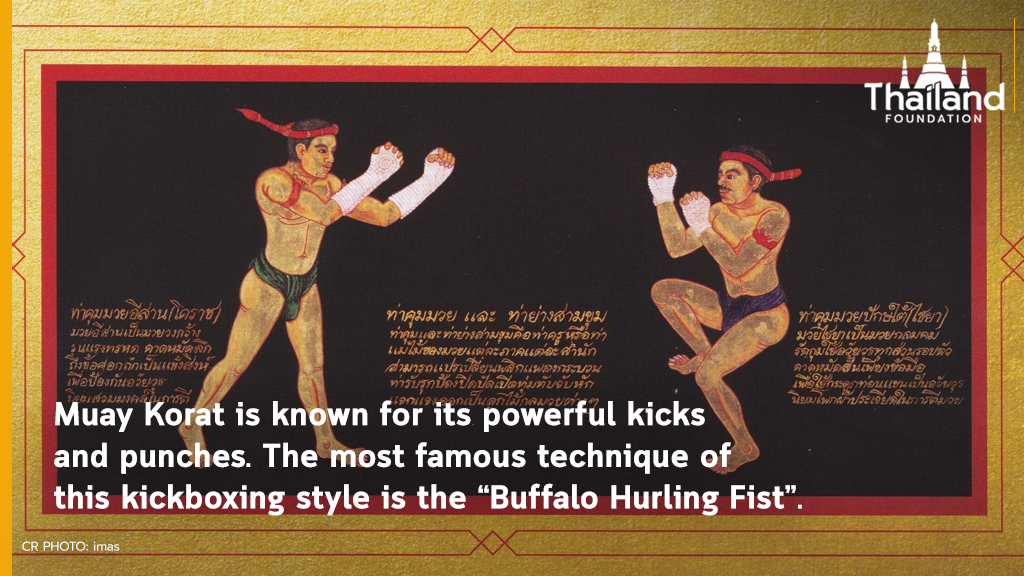
As a strategic frontier city in the Ayutthaya period (1350-1767), the city of Korat (currently a province in the northeast of Thailand, also known as Nakhon Ratchasima) had to be protected at all costs. For this reason, the people of Korat were born fighters and their weapon was Muay Korat [มวยโคราช]. Today, this martial art is one of the four surviving styles of Muay Boran or ancient kickboxing.
History and changes
When King Rama I established Bangkok as the new capital of Thailand (then known as Siam) in 1782, it ushered in a new age of the Thai civilization: the Rattanakosin era. The dynasty founded by King Rama I is known as the Chakri Dynasty, and is the current ruling Royal Family of Thailand. Throughout the Rattanakosin era, Muay Korat has gone through major changes and has even played an important role in helping to defend the nation. The periods of changes in this style of fighting roughly coincide with the changing of the ruling monarchs.
- Muay Korat as a Weapon of War (King Rama I – King Rama IV)
The beginning of the Rattanakosin era was marked by military threats, both from foreign forces and rebelling vassals. In 1827, Lady Mo, the wife of the Governor of Korat, led the people against the troop of King Anuwong of Vientiane during the advent of the Lao Rebellion. Using the techniques of Muay Korat, the people of the city was able to fight off the Laotian army. For her bravery, Lady Mo was granted the title of “Tao Suranaree” by King Rama III.
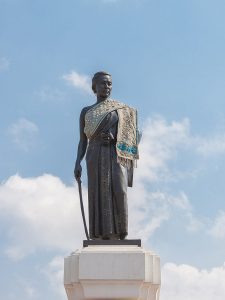
Tao Suranaree [Wikipedia]
- The Golden Era (King Rama V – King Rama VI)
King Rama V was fond boxing and often sponsored matches with contestants coming from all regions of the kingdom. The King’s son, Prince Abhakara Kiartivongse, also welcomed many skilled fighters to practice in his palace. Muay Korat was recognized as art form with support from King Rama V, who bestowed the noble title “Muen Cha-ngat Cherng Chok” (a sure puncher) to Daeng Thaiprasert, a boxing maestro from Korat. When the King’s other son, Prince Vajiravudh, succeeded the throne as King Rama VI, he continued his father’s effort to support the art of boxing.
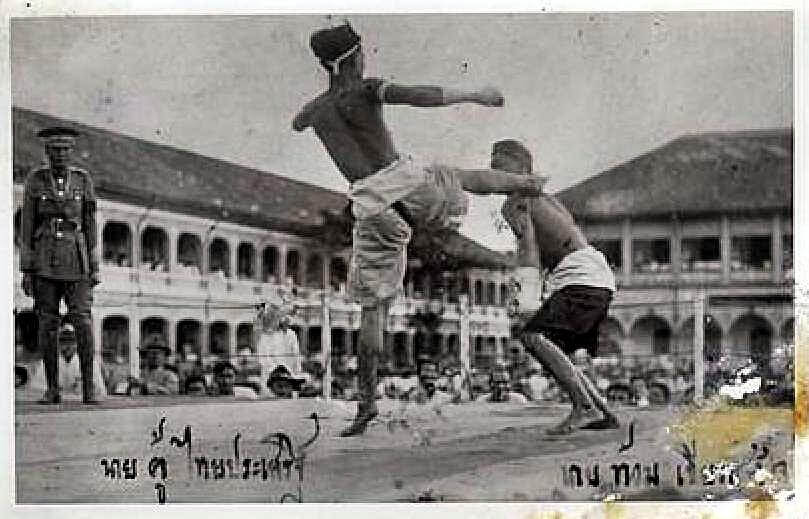
Muay Korat fighter Tu Thai-prasert (brother of Muen Cha-ngat Cherng Chok) kicking a contestant at the Suan Kularb School Stadium
[FB: โคราชในอดีต]
- The Glove Era (King Rama VI – King Rama VIII)
Under the guidance of King Vajiravudh, Muay Thai was developed into a proper sport with standard rules and regulations. Boxers started wearing boxing gloves instead of tying threads around their fists after a fatal boxing match that took a life of a boxer. This era saw the emergence of private boxing schools, an influx of Korat boxers into Bangkok, and a Muay Korat curriculum in the Royal Cadet School.
- The Business Era (King Rama IX – Present)
A celebrated Korat boxer in this era was “Suk Prasat-hinphimai. Born in Phimai, Korat, Suk competed for the first time in 1931 at the age of 21, but was imprisoned as he turned 27 for homicide. Upon his release, Suk, 34, returned to the ring. His unmatched techniques and powerful punch earned him the title “Hok Mokkhasak” (Mokkasak spear, a deadly weapon in the Ramayana epic). After he passed way at the age of 90, a monument was erected in Phimai in his memory.
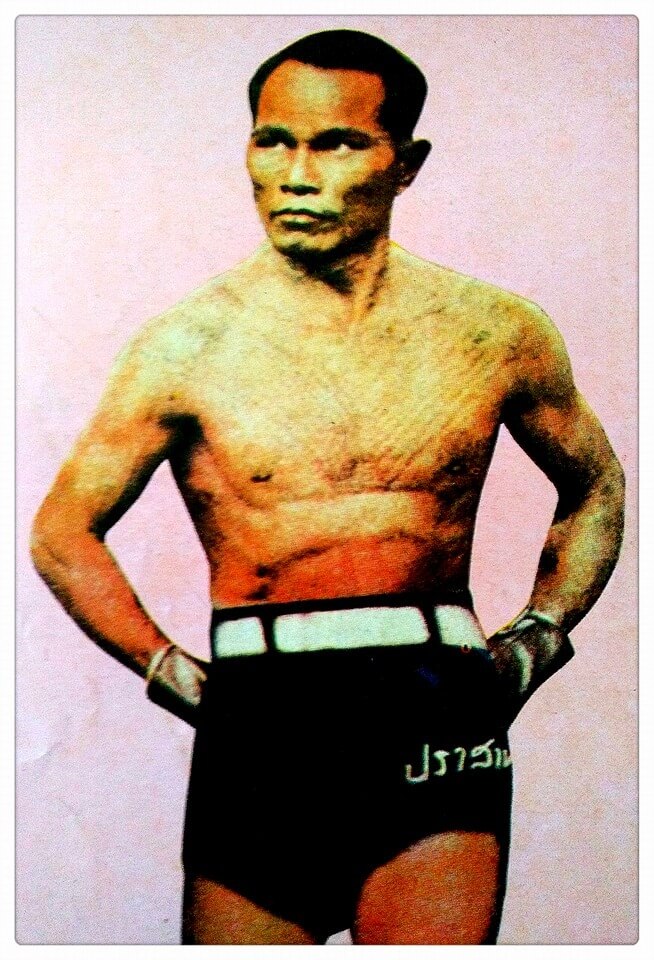
Suk Prasat-hinphimai [FB: มวยไทย – สุรพล เวียงวงษ์]
At present, the practice of ancient Muay Korat as a revered form of martial arts is not as prominent as before; instead, it principally serves entertainment and business purposes. Fortunately, those who wish to delve into this art form can do so in a few Korat boxing schools that operate today.
Identity
Muay Korat is known for its heavy and forceful attack. One respected teacher of Muay Chaiya once said that a Muay Korat kick was a neck-breaking kick, or could even detach the head from the body. Equally savage is the punch known as the “buffalo hurling fist” [หมัดเหวี่ยงควาย]. Each kick and punch is normally released in a wide angle or as a swing, but during the infighting, straight strikes are preferred. The stance of Muay Korat is elegant and flexible: the boxer puts the weight on the front foot, extends the fist from the arm of the same side, and lifts the heel of the other foot like tiptoeing.
Another element that differentiates Muay Korat from other boxing styles is the use of physics to, for example, dampen the impact of the opponent’s attacks or increase the intensity of the boxer’s strikes. These techniques are called “force enhancing” and “force transferring.” A good Korat boxer must understand the rule of physics to know when to resist and when to go with the flow, which movement will gain him more strength or save him from serious injuries.
Muay Korat teachers are also known for their creativity in inventing boxing moves and reading games. Their goal is make students become better boxers than they are to ensure the survival of the art while teachers of other schools will keep the best techniques to themselves.
Techniques and training
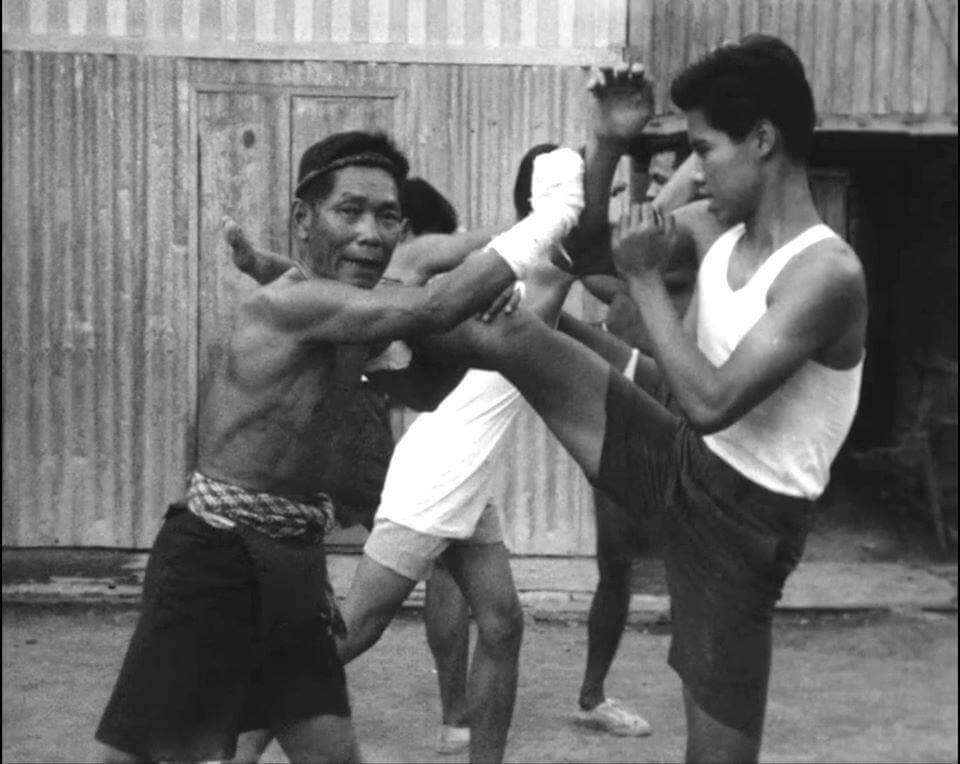
Master Bua Nil-acha instructing a student [FB: โคราชในอดีต]
In ancient times, boxers would train their strength and focus with daily life objects or activities, such as retrieving water from a well, carrying water buckets, pounding rice, cutting firewood, climbing trees, running through rice fields, rolling on the grass soaked in morning dews, gazing at the dawning sun without blinking, running in deep water, or using both hands to chop on water and trying not to blink when water droplets hit the eyes. To perfect the stance, the punch, the kick, the knee and the elbow, they would tie ten limes to a rod and punch or elbow them, making sure that the limes did not fall or hit their faces, and the rope not tangle. There was no shortcut to become a mighty Korat boxer. It took many years to perfect the following renowned techniques.
- A Korat boxer may combine a footwork known as “draw in – draw out”or “spew back out” with punches to trick his opponent into thinking that he has lost control, luring the opponent to rush in for a strike just to be attacked at the most unexpected moment.
- As the name suggests, “the buffalo hurling fist” is said to be so powerful that it could send a buffalo up in the sky. The boxer must swing his arm wide and launch the punch sideway using the back of his hand as the point of contact.
- Five maestro mae mais (standard moves) of Muay Korat
- “Retract the punch, and kick with the front foot.”– Draw the punch back and kick the opponent’s chest or chin.
- “Cover yourself and hit with elbows.”– Use your fists to block the opponent’s punches and counter with elbows.
- “Shoulder punch”– Brush off the opponent’s attacks and punch his shoulder.
- “Enter with a wide-angle punch, and exit with a narrow one.” – To break the opponent’s defense, you must first attack with a wide-angle punch. The opponent will respond by shoving the punch away. You will then take this opportunity to land a punch on his chest or mouth before retreating quickly.
- “Colliding punch”– This is a counter punch landing on the opponent’s face. As you release the punch, lean your head against the extending arm.
- Twenty-one ancient mae mais of Muay Korat
- Tadmala (putting a flower on the ear)– Cover your ear with a fist and then elbow your opponent, or cover your ear with your elbow and punch the opponent with the other hand.
- Ka Cheek Rang (a raven tearing up the nest) – Use both hands to break the opponent’s fists from the middle to both sides. Follow with a kick.
- Hanuman Tawai Waen (Hanuman offering the rings)– Grab the opponent’s elbow and lift it up with one hand. Then, punch his mouth with the other hand.
- Lom Ploy Aye (When the enemy falls, you feel embarrassed also.)– When the opponent falls, fall on top of him and elbow him at the chest or the feet.
- Ling Ching Look Mai (monkeys fighting for fruits)– After warding off the opponent’s kick, perform a double uppercut on his chest or chin.
- Kumphakan Hak Hok (Kumphakan breaking the spear) – When the opponent kicks, grab his leg and performs a knee strike on it.
- Rusi Long Sa (a hermit entering the pool)– When the opponent jumps to kick, squat down quickly and use both hands to spread the his legs, slip yourself between the legs, lift the opponent with your back and throw him backward.
- Tosakan Sok (mourning Ravana) – When the opponent jumps to kick, punch his chin.
- Tapian Fang Toh (a carp hiding between stumps)– Upon reaching your opponent, bend down and press your hands on his legs. When he attacks, double punch his rib or chin.
- Nok Koom Kao Rang (a quail entering the nest)– Put both hands under your opponent’s arm to swipe his hands away. Then, hit his chest.
- Kotchasarn Kwat Ya (an elephant sweeping grass)– Pretend to make a wide-angle punch. When the opponent brushes it off, grab his fists, locking them under your armpit. Use the other hand to punch his mouth or nose. Before jumping out, elbow his chest.
- Hak Lak Phet (breaking the diamond pole)– This move is similar to the carp move, but you do not press the opponent’s legs. When the opponent kicks, quickly lift his leg and hit the foot of his standing leg with your heel.
- Kotchasarn Tang Rong (an elephant destroying the hall) – Jump and land a straight kick on the opponent’s chest. Then, punch his mouth with both fists.
- Hanuman Waek Fong (Hanuman breaking bubbles) – Pretend to launch a punch, but then jump to side, put both of your hands on the ground to support yourself, and kick the opponent in the face. Then, dodge behind him.
- Ling Pliu (a flexible monkey)– Pretend to launch a straight punch but immediately turn around and elbow your opponent back in the face.
- Nok Ka Lot Huang (a raven going through a hoop)– When your opponent kicks, duck so that his leg swings over your head. Then, hit him at the chin or chest.
- Hanuman Bag Phra (Hanuman carrying a monk)– When the opponent jumps to kick, duck between his legs, and grab his standing leg with one hand while the other hand grabs his armpit. Lift the opponent and throw him on the ground.
- Noo Tai Rao (a mouse scaling a tight rope)– When the opponent kicks or punches, dodge to the side and kick or punch him immediately.
- Talop Nok (catching a bird with a net)– Pretend to punch the opponent’s rib cage. When he defends it, pull back the hand and elbow his head.
- Kohok (telling a lie)– Pretend to throw a punch. While the opponent is defending it, launch a straight punch at his mouth, followed by more kicks and punches immediately.
- Hanuman Torn Toh (Hanuman removing a stump)– When the opponent kicks, grab his leg and lift it to the shoulder height and kick his pelvic area.
Wai Khru movements
Like other Muay Thai schools, Muay Korat has its own wai khru [ไหว้ครู] dance which boxers must perform before fighting to bring good luck, calm his mind, study the environment, and to intimidate opponents. The five moves in the wai khru dance of Muay Korat are as follows:
- Thaksinawat Walking – Walk clockwise around the ring, hands at the side of the body.
- Krap Benjangkhapradit (Buddhist five-point prostration) – The boxer sits in the Theppabutr posture (sitting on the heels) and bows down to the floor, making sure the nose and the hands touch the floor.
- Kob Mae Phra Toranee (embracing Mother Earth Goddess) – Sit in the Theppabutr posture and move both hands backward and then forward like scooping up soil and raise the hands to the chest. Put the palms together.
- Tawai Bangkom (paying homage to the King) – Continuing from the embracing Mother Earth Goddess posture, move the palms to the head so that both thumbs are at the middle of the forehead and pull them down to the chest again.
- Yang Sam Khum (three-pit walk) – Move both fists in a circular motion. Start by pushing the right fist away from the chest and back and do the same with the left hand. To walk, lead with the left foot, the left hand at the waist and the right hand at the shoulder level.
Outfit
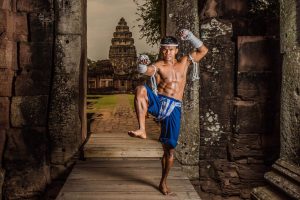
Since Korat boxing uses wide-angle punches, the boxers will wrap their hands with threads up to the elbow to prevent injuries and dampen the impacts from kicks and punches. The threads must be prepare by soaking them in rice water and leaving them to dry and harden. Boxers wear only shorts, no shirt or shoes, and wrap a phakaoma [ผ้าขาวม้า] cloth in a triangular shape to protect the genitals. A sacred napkin, or prajiad [ประเจียด], is tied at the forearm on both sides, and an auspicious garland called mongkhon [มงคล] is placed on the head at all the time. If the mongkhon [มงคล] of either of the competitors falls off, both sides will stop fighting and allow the other to pick it up again.
—————————-
With a long history and formidable power of Muay Korat, it is no surprise that this martial art manages to maintain its majestic aura until today. Although its original purpose as a war weapon has faded out of importance, Muay Korat will always remain a fascinating science and art, and above all, the pride of the Thai people.
Sources
- https://www.youtube.com/watch?v=iWRGAAbMIIc
- https://www.youtube.com/watch?v=4NpluNKr7Kk
- https://www.youtube.com/watch?v=qTBsbj38pGA
- https://jaroenthongmuaythaisrinakarin.com/blog/read/32
- https://sites.google.com/site/dongdeng2561/mwy-khorach-phakh-xisan
- http://digital_collect.lib.buu.ac.th/dcms/files/57920321.pdf
- https://www.taifudo.com/taifudo54-th/
Author: Soonyata Mianlamai
Editor: Tayud Mongkolrat


